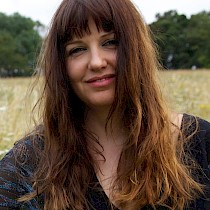Dr. Lily Hibberd

Future memories: immersive media and collaborative artistic reconstruction of the past
Dr. Lily Hibberd ist eine interdisziplinäre Künstlerin, Kuratorin und Autorin, die an den Grenzen von Zeit und Erinnerung arbeitet. Sie ist vom Australien Research Council als Forschungstipendiat gefoerdert und arbeitet am Nationalen Institute fuer Experimentelle Kunst (NIEA) an der University of New South Wales Sydney, Art & Design.
Das Stipendium ist im Bereich der Medienforschung angesiedelt und basiert auf einer Kollaboration mit den ParraGirls. Sie promovierte in Fine Art an der Monash University Melbourne. Lily ist Gründungsredakteurin der halbjährlichen Kunstschrift-Publikation un Magazine und ist gleichermaßen bekannt für ihre Praxis als Künstlerin und kritische Autorin.
2012 gründete sie zusammen mit Bonney Djuric das Parragirls Memory Project. Als Kreative Direktorin (2012-18) hat sie zusammen mit Parragirls und anderen Projektmitarbeitern zahlreiche bedeutende Arbeiten, Ausstellungen, Artikel und Publikationen verfasst. Von 2016-17 arbeitet sie an Parragirls Past, Present mit Parragirls und Medienkünstler Volker Kuchelmeister und Alex Davies.
Lily hat in großen Institutionen und Festivals in Australien und Europa ausgestellt. Weitere Projekte sind Data Horizons für das Edinburgh Science Festival (2017, Multimedia-Installation); The Public Secret (2017, immersive Videoinstallation); The Phone Booth Project mit Curtis Taylor (2012-2017, immersive Videoinstallation); First Light für das Internationale Jahr des Lichts der UNESCO im Musée des Arts et Métiers, Paris; β Persei in Partnerschaft mit l'Observatoire de Paris in der Galerie de Roussan, Paris (2015, Multimedia-Installation).
Synopsis
Title: Future memories: immersive media and collaborative artistic reconstruction of the past
Presenter: Dr Lily Hibberd (Université de Paris, FR/UNSW AU)
ABSTRACT
More people than ever and, for that matter, more species are living on the edge. And some of our most significant global stories, cultures and sites are under threat. But what role can immersive media play in such a climate of crisis? How can it contribute to reviving a world mnemonic economy? While forms immersion, from panoramic and widescreen video installation to fulldome cinemas, are not new technologies, the means to create them are more accessible than ever. As artists embrace the possibilities of the medium, distinctively new ways of reconstructing memory and place are emerging. And yet the democratization of immersive storytelling faces its own challenges.
Immersion not only creates a sense of place and presence in it and/or with other beings; it is also a means to remake the past. For the caretakers of cultural memory on the margins and for heritage at risk this capacity is crucial. Yet, the ways that we “think” narrative are radically changing with the transformation from passive viewer to active audience member. Participation is, however, not only about cues and tactile engagement with the interface, or ‘choosing your own adventure’. Engagement requires the audience to cease being spectators and to merge with the world of the storyteller, as shown in this talk.
The collaborating artists on each of the projects being presented have remade and reimagined their own memory through an immersive medium. This is a crucial component for the liquid, immersive storytelling form required to engage the user’s imagination; one that should not be overlooked in user-focused immersive design. If a person whose world into which we are being immersed is marginalized from the means of production then the creation of the experience remains external to them. But when we place the imagination of collaborating storytellers at the center of the creation, something even more powerful is possible, as we will see in these examples.
Alle Sprecher
- Fouzia Adjailia
- Claudio Agosti
- Thorsten Bauer
- Vaishak Belle
- Jan Boelen
- Daniel Deboy
- Prof. Dr.-Ing. Barbara Deml
- Hon. Prof. Joséphine Derobe
- Florian Dohmann
- Declan Dowling
- Felix Gaedtke
- Holger Förterer
- Prof. Dennis del Favero
- Owen Green
- Dr. Lily Hibberd
- Alejandra Janus
- Sönke Kirchhof
- Marco Kempf
- Professor J. Stephen Lansing
- Roman Lipski
- Prof. Dr. Eduardo R. Miranda
- Lauren Moffatt
- Prof. Andrea Nanetti
- Jules Rawlinson
- Dave Murray-Rust
- Prof. Dr. Dr.-Ing. Jivka Ovtcharova
- Gülsel Özkan
- Gayatri Parameswaran
- Eleanora Pfanz
- Hans-Martin Rall
- Prof. Elke Reinhuber
- Dr. Ralf Schäfer
- Dr. Christoph Schneider
- Dr. Markus Schmidt
- Patrick Scislowski
- Kathleen Schröter
- Prof. Aljoscha Smolic
- Prof. Vibeke Sorensen
- Will Stronge
- Holger Volland
- Prof. Charles Wang
- Yulu Wang
- Dr. Matthias Wölfel
- Tobias Wursthorn
- Wang Zhigang PH.D
Kontakt
Interesse? Fragen?
Schreiben Sie uns:
info@beyond-festival.com




